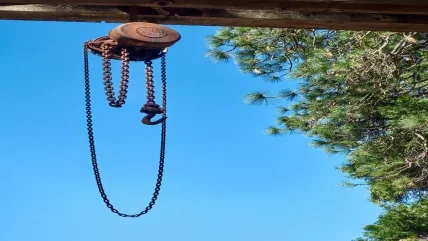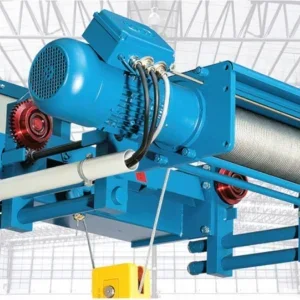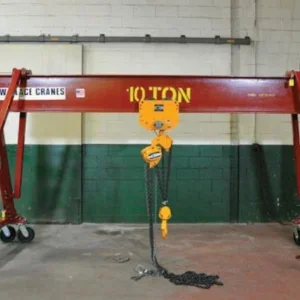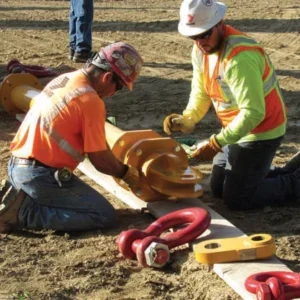
Phil Simpson is an engineer at CraneServe, a crane maintenance and inspection company based in the UK. In his job, he comes across all forms of lifting equipment, including electric and manual chain hoists.
The types of faults he sees include issues with safety catches, chain stretching, hooks stretching, contortion, and worn top return sprockets.
Overloading is usually the cause of such problems, with people using equipment for tasks they haven’t been designed for; for example – taking a load with a manual chain hoist, and then lifting it further with a crane.
“Obviously,” says Simpson, carrying out manoeuvres such as that “tends to overload the hoist, and then it can elongate the chain or smash brake pads, and stuff like that.”
Another issue he sees is contamination.
“You tend to find brake disks can get contaminated on the inside with grease and lubrication, and the atmosphere they’ve been in affects the sort of contamination they can have,” says Simpson. “Obviously, in dusty environments, dust can get in and contaminate the brake disks, so you can have load slips and stuff like that.”
Contamination can also take the form of what Simpson calls “grinding paste”.
He continues: “If you are lubricating the chain, the environment needs to be considered. For example, if you were working in a welding bay and there’s a lot of contamination in the air – welding particles, or even a dusty environment – what can happen is if you put a thick grease on the chain, all that contamination in the air sticks to the chain. So as it’s going over the top return sprocket, it’s basically dragging through debris. It’s making a grinding paste and making things worse.”
There are alternatives to greasy lubricants, as Simpson highlights: “Obviously, if you use quite a runny lube, or a thick greasy lube in humid conditions, it can drip. What we would normally recommend is a PTFE, dry moly or graphite lubricant spray – a dry lubricant for those sort of conditions – so it’s not dripping down and contaminating the product.” He adds that he has recently recommended a dry lubricant to a customer running a paper factory.
While Simpson says it’s up to customers under the Provision and Use of Work Equipment Regulations (Puwer) to maintain their equipment to the required standards, the reality is that all too often they don’t even carry out pre-use examinations.
“By right, they should be doing a pre-use check before they use any sort of lifting equipment,” he says. “But, obviously, nine times out of ten times they don’t do it. They just tick a box and say they have looked at it – in reality, that could be very dangerous.”
CraneServe offers its customers an examination scheme, as Simpson explains: “Different situations require different types of examinations at different times. What we normally put in place is an examination scheme, where we sit down with the customer and say, ‘look, what would you like inspected on this?’ Or ‘we would recommend doing this at these periods’.”
As an example of what CraneServe can offer, Simpson refers to one of its customers, a manufacturer.
“They have these carriers that are in use 24 hours a day, seven days a week,” he begins. “We’ll drop five out every week and we’ll strip them down, inspect them, relubricate them and put them back into the system.
“And we’ll make an examination scheme where we’ve developed our own reports. It’s basically a check list: have you inspected the bearings, the bushes etc? And then if we do make any repairs, we note them down and report them to the customer.
“Obviously, you can do this with any sort of lifting equipment and maintenance on cranes – as long as there’s a history of what’s being done to that piece of equipment and at what time scale.
“If it’s in frequent use and it’s getting hammered 24 hours a day, lifting near a safe working load, you’d probably recommend an examination scheme of every three months or every six months, depending on the equipment and the environment it’s in.”
The company also provides training.
“I think that’s very important to be honest. The right training goes a long way,” says Simpson.
“I think a lot of operators are very unaware with what they’re actually looking at, and there are a few times where I’ve pointed out something to an operator and they’ve been ‘Oh – I didn’t know that’.
“I would probably say get some training, and then get actual pre-use check cards in place as well so that you’ve got an assigned visual there [that confirms] the equipment’s been looked at. Even if it’s a weekly check, a monthly check, daily check, whatever – just as long as it’s getting looked at by somebody who’s got that knowledge and had that training.”
Training, says Simpson, would help operators to spot the danger signs early before they become a safety concern. He says the first thing he would do is start with the hooks and ask whether they are distorted or stretched. Also ask, for example, whether the safety catch is working and engaged properly? Normally, if the hook stretches, the safety catch won’t be engaging and will be “flipping about”. And examine bearings, and the chains, mainly in the saddle of the links. As Simpson says, with any sign of wear in the link, “it’s best to nip it in the bud and get it changed before it gets any worse”.






